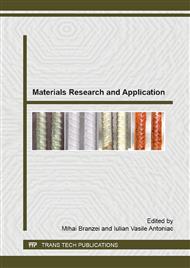[1]
Wright, P.K. and Evans, A.G. , Mechanisms governing the performance of thermal barrier coatings, Current Opinion in Solid State and Materials Science 4 (1999) 255-265.
DOI: 10.1016/s1359-0286(99)00024-8
Google Scholar
[2]
DeMasi-Marcin, J.T. and Gupta, D.K. Protective coatings in the gas-turbine engine, Surface and Coatings Technology 68 (1994) 1-9.
DOI: 10.1016/0257-8972(94)90129-5
Google Scholar
[3]
Nicholls, J.R. Designing oxidation-resistant coatings, Journal of the Minerals Metals and Materials Society 52 (2000) 28-35.
Google Scholar
[4]
D.R. Clarke, The lateral growth strain accompanying the formation of thermally grown oxide, Acta Mat. 51 (2003) 1393-1407.
DOI: 10.1016/s1359-6454(02)00532-3
Google Scholar
[5]
C.G. Levi, Emerging materials and processes for thermal barrier systems. Curr. Opin. Sol. St&Mat. Sci. 8 (2004) 77-91.
Google Scholar
[6]
Angenete, J., Stiller, K., and Langer, V, Oxidation of simple and Pt-modified aluminide diffusion coatings on Ni-base superalloys, Oxidation of Metals 60 (2003) 47-82.
DOI: 10.1023/a:1024665229656
Google Scholar
[7]
Leyens, C., Pint, B.A., and Wright, I. G, Effect of composition on the oxidation and hot corrosion resistance of NiAl doped with precious metals, Surface and Coatings Technology 133 (2000) 15-22.
DOI: 10.1016/s0257-8972(00)00878-1
Google Scholar
[8]
C.G. Levi, E. Sommer, S.G. Terry, A. Catanoiu, and M. Ruhle, Alumina grown during deposition of thermal-barrier coatings on NiCrAlY, J. A. Seram. Soc. 86 (2003) 676-685.
DOI: 10.1111/j.1151-2916.2003.tb03357.x
Google Scholar
[9]
C. Leyens, U. Schulz, B.A. Pint, and L.G. Wright, Influence of electron beam physical vapour deposited thermal barrier coating microstructure on thermal barrier coating system performance under cyclic oxidation conditions, Surf. Coat. Technol., 120 (1999).
DOI: 10.1016/s0257-8972(99)00343-6
Google Scholar
[10]
J. A Haynes, M.K. Ferber, W. D Porter, and E. D. Rigney, Characterisationof alumina scales formed during isothermal and cyclic oxidation of plasma-sprayed TBC systems at 1150C, Oxid. Met. 52 (1999) 31-76.
Google Scholar
[11]
Chakravorty, S. and West, D.R. F, Scripta Metallurgica 19 (1985) 1355.
Google Scholar
[12]
Wolff, I.M. and Hill, P. J, Platinum metals-based intermetallics for high temperature services, Platinum Metals Review 44 (2000) 158-166.
Google Scholar
[13]
B. Tryon, T.M. Pollock, M.F.X. Gigliotti, K. Hemker, Thermal expansion behaviour of ruthenium aluminides, Scripta Mat. 50 (2004) 845-848.
DOI: 10.1016/j.scriptamat.2003.12.009
Google Scholar
[14]
I.M. Wolff, Synthesis of RuAl by reactive powder processing, Met. Mat. Trans. A. 27 (1996) 3688-3699.
DOI: 10.1007/bf02595461
Google Scholar


